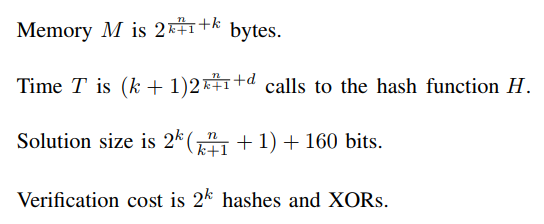Bonus Content: The Complexities
Why does an <n,k> like <144,5> require more memory than <200,9>?
The Equihash algorithm does, as part of the process, two major functions:
First, it makes a huge amount of data by creating a huge number of strings with a hash (Blake2b), and then Second, it uses that data with an algorithm (Wagner’s) which requires all of that data to be around.
So, how many strings? It’s found with the formula:
![]()
So, for <200,9>, that’s 2 ^ ( (200 / (9+1) ) + 1), or 2 to the 21st power, or 2,097,152.strings.
But for <144,5>, that’s 2 ^ ( (144 / (5+1) ) + 1), or 2 to the 25th power, or 33,554,432 strings.
This is sixteen times more. This means more required memory just to make the algorithm possible. And with either set of parameters, finding solutions efficiently requires several times that amount of memory - remember, using half as much memory causes a 1000 X penalty in performance.)
What else changes?
That’s not the only thing that changes with these simple parameters:

Each of these is, from our perspective, an improvement.
Writing an efficient miner to use these new parameters turns out to be a lot of work - the optimized code for <144,5> is very different than the setup for <200,9>, which means the writers of mining software have a tough job, but they’re already hard at work. Their new mining software may be less efficient at first, and improve over time - but that’s OK, it’s still fair when everyone has access to the software and can run it on their GPUs.
Miner Revenue
Some people are concerned that the new <144,5> parameters will produce fewer hashes per second - a lower hashrate - and that this will mean less revenue for miners. Not true! Sure, the hashrate will be lower, but all miners will be producing at the same lower rate when mining BTG, so it’s still a fair distribution based on power contribution. The net revenue for mining will stay the same - 12.5 BTG per block - and it will still be distributed among roughly the same number of miners after the mining market re-balances. In the end, the profitability will be roughly the same as before the fork.
If miners are slow to come over to the new software necessary to mine BTG, then the few who come over first will simply earn much higher revenue. If only half the current miners come over, they’ll be earning twice as much! That won’t last long, as more miners will come over to take part. In the end, we expect to have about the same number of miners after the upgrade as we did before. Since the reward is staying the same - 12.5 coins per block - any change in overall mining revenue will be a result of changes in the price of BTG, something which is decided on the open market.